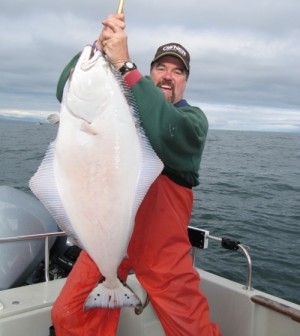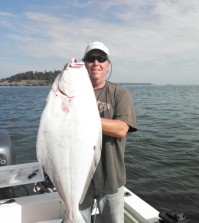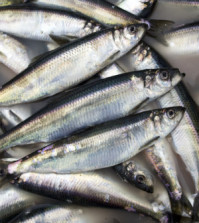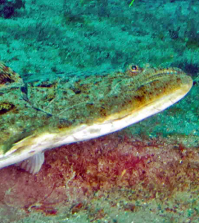Bait/Lure Combos for Halibut

One of my fishing buddies likes to say that halibut are so easy to fool that you probably could catch one on a hubcap off a ’54 Ford. That might be possible in places like Admiralty Sound, Dutch Harbor and other northern destinations where there are lots of halibut large enough to inhale car parts, but down here near the southern end of the Pacific halibut’s range there aren’t that many hubcap-eating 300-pounders, and even the 15 to 50 pound hallies that make up the bulk of the catch are often few and far between.
So, rather than trying to figure out ways to rig a hubcap, we’re much better off fishing with something a little smaller and a lot more enticing. Artificials—metal jigs, leadheads with various plastic bodies, pipe jigs and the like—catch a lot of halibut, but many anglers swear by herring, anchovies, squid and other baits for day-in and day-out results on the halibut grounds. For many years I was an avid halibut jigger, and I had my share of 10-fish days, both on metal, slab-type jigs and leadheads. Then, after a morning in Petersburg when my two fishing buddies, using fresh herring, caught and released nearly two-dozen halibut while I went fishless with all my favorite jigs, I became a pretty serious bait fisherman.
For the past several years, though, I’ve carried both artificials and bait on my halibut trips, and probably 90 percent of the time I use the two in combination. Like other fish, halibut use their senses of sight, smell and “hearing” (through their lateral line) to locate and home in on a potential meal, so bouncing a bait/lure combination along the bottom provides an offering that may pique any or all of these senses and increase the likelihood that a halibut will find its way to the end of my line.
One of the disadvantages of fishing bait by itself, especially some of the softer, less-durable baits like herring or anchovies, becomes painfully obvious when you’ve been fishing for three hours, get a good take-down, rear back to set the hook…and miss. Now what do you do? Did you lose your bait? Probably, but if you’re fishing in 300 feet of water and have more than 350 feet of line off the reel, what do you do about it? By the time you retrieve all that line to check your bait you’ve drifted 150 yards from where the fish is and have no chance of getting a hook back down to the right spot. But if you leave your rig down there in hopes of getting the fish to come back, and your bait’s gone, you’re wasting your time anyway.
If, on the other hand, you’re fishing bait and some kind of artificial together when you miss that strike, you quickly throw the reel into free-spool and get that pipe jig, leadhead or whatever it is back down there as fast as you can, because the halibut that just scored a free appetizer is now probably in the mood for an entrée, and chances are good that he’ll open up and say ahh for anything that looks like food. Your ability to keep on fishing after a missed strike and a lost bait will, over the years, put a fair number of halibut in your fish box that you would have otherwise never hooked.
The bait/lure combination that’s worked best for me the past year or two—and therefore qualifies as my current favorite—is a whole herring and large plastic squid skirt. Black label baits (9 to 10 inches) will do the job, and are the biggest I’ve been able to get my hands on the past couple of seasons, but if I can find the big guys, like 12- to 14-inchers from up north, I’ll use those instead. Whatever the bait size, I fish them whole, sometimes with a single hook and sometimes with a pair of hooks tied in tandem, like a salmon mooching leader on steroids. Whether I use one or two of them, my hook of choice is a size 10/0 Owner SSW with Cutting Point. My decision to use one hook or two hooks is sometimes based on bait size, but not always. If I’m using a teaser rig with a second offering two or three feet up the line, I have to single-hook the herring, because the law allows only two hooks on a line at one time. If you use a two-hook rig, all you have to do is run the upper hook through the herring’s snout from bottom to top, then seat the lower hook into the side of the bait a short distance in front of the tail. For single-hook rigging, run the hook up through the snout from bottom to top (about three-eights of an inch back from the tip), draw it around and run it through the same hole a second time, forming a leader loop at the tip of the snout. Feed enough leader from the loop to seat the hook about three-quarters of the way down the side of the bait.
As for the squid skirt, all you have to do is run it down the leader so that it drapes over the upper two-thirds (or so) of the herring. Depending on the size of the bait, I use a skirt of six to eight inches long. When using a two-hook rig, I may slide a couple of large beads down the leader ahead of the skirt, keeping it up the leader just high enough to expose the top hook at the base of the skirt’s head. With a single-hook rig, I push the head of the bait up into the skirt head as far as it will go, because the hook is in the clear well back toward the tail-end of the bait. I like bright, contrasting colors that will stay visible at substantial depths, and have done well with skirts in such combinations as blue/white, green/white, green/orange, chartreuse/orange and blue/pink, as well as solid white and solid pearl.
Nearly all of the larger plastic squid skirts I’ve used come out of the package smelling like anything but halibut food, so I usually marinate them in liquid scent of some kind for an hour or two before sending them to the bottom. Any of the commercially available scents will do the job, or mix up a batch of home-grown scent by grinding up a little salmon, squid, herring, shrimp or clam and mixing it with equal parts of vegetable oil. For good measure, you can smear a little Smelly Jelly, Gel Krill or similar paste-type scent on the squid skirt as well.
I should point out that while herring baits are usually the most readily available for use with a squid skirt, there are lots of other options, and some of them are more durable and stay on the hook longer and better than herring. If you can catch a couple of greenling, tomcod, pollock or other saltwater species before or during your halibut trip, by all means save them and rig them the same way you would a herring of equal size. If you can keep these baits alive until it’s time to use them, all the better. A fresh or frozen salmon belly is another great alternative to a herring bait, especially when fished under a squid skirt. I like a belly strip one to two inches wide and 10 to 12 inches long, and that’s usually what I have left when I finish filleting a late-summer or fall coho, so I tend to save, vacuum-seal and freeze about a dozen coho bellies every season. In a pinch I’ll do the same with the bellies of pink salmon, and if they’re too small I’ll use two of them together, one on each hook.
Another effective bait-lure combination for halibut is a metal jig with a bait strip on the hook. It works best with a single hook rather than a treble, and since singles are now required in Washington, most of my fellow halibut anglers are rigging them the same way I always have. Pipe jigs and halibut-size metal slab jigs don’t really have a lot of built-in wiggle and wobble anyway, so hanging a strip of salmon belly, halibut skin, squid or razor clam adds scent and flavor without detracting from the lure’s action. All of the aforementioned baits are tough enough to stay on the hook for hours, usually even through at least a couple of missed strikes. You can also use softer baits, such as herring strips or whole anchovies, behind your jigs, but they tend to come off the hook pretty quickly under normal use, and almost always disappear when a fish hits the jig.
Like pipe jigs and slab-type metal jigs, leadheads can also be used in conjunction with bait to make an effective halibut-getter. I’ve taken a number of decent halibut while fishing a whole squid on a skirted leadhead, and have also used salmon bellies, shiner perch and other small baitfish on leadheads.
Many times over the past 20 years or so I’ve written and spoken about the advantages of using a teaser rig when halibut fishing, and one of the main advantages of teasers is that they make it very easy to fish bait and artificials at the same time. I usually fish a teaser off the in-line swivel that connects my braided main line to my monofilament leader. It’s nothing more than a very short piece of heavy, stiff mono with a size 7/0 to 9/0 hook at the end. The beauty of a teaser rig is that you can fish bait (on a spreader or slider rig with a cannonball) at the bottom of the leader and an artificial (pork rind, small squid skirt or curl-tail grub) on the teaser hook, or reverse it and use a pipe jig or large leadhead as both the weight and mail lure on the bottom and a belly strip, whole squid or another small bait on the teaser. Either way, another advantage of the teaser rig is that it puts one offering right down on the deck and a second two or three feet up in the water column, where it’s more visible and may draw in potential customers from a greater distance.










